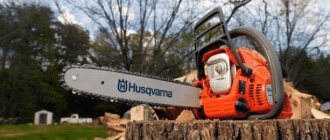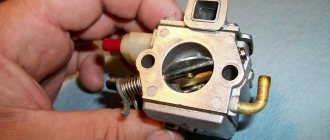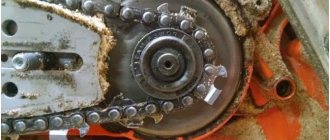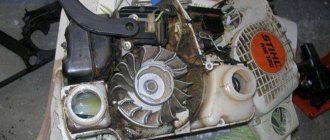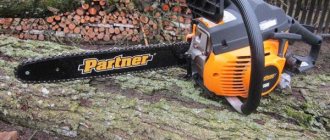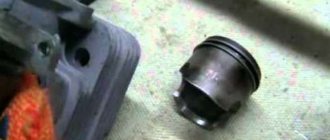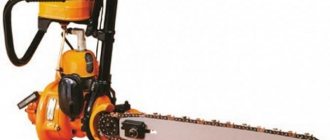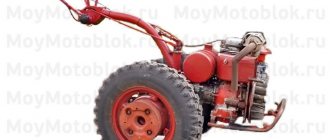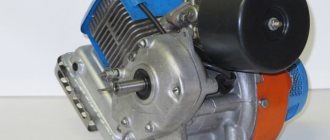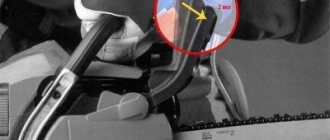The design of the carburetor on the Partner-350 chainsaw. Description and technical specifications
The Partner 350 chainsaw is an example of an excellent workshop saw, suitable for various types of work in the garden, collecting firewood, etc. Compared with, the Partner 350 is very necessary when it comes to periodic use at low load levels.
It is important to note that the unit has a chrome-plated inner surface of the working cylinder, which allows the operating life of the device to be significantly extended. This chainsaw has a good air purification system, CCS marking. In other words, it will be said that the unit uses an air purification system, which is based on the principle of a conventional centrifuge.
After cleaning, the air prepared for work will flow through special filters into the carburetor. If you are interested in setting up the carburetor of the Partner 350 chainsaw, then we inform you that you can easily disassemble and clean it on your own. To adjust the carburetor, simply add air to the system and let it run empty for a minute. Then accelerate several times in a row, but slowly. Look
If “failures” are observed in dynamic operation, then you will need to unscrew the L-screw L by ¼ of its turn and recheck everything again. As you can see, adjusting the carburetor of the Partner 350 chainsaw with your own hands is possible and is not particularly difficult.
Chainsaw device PARTNER 350
The design of the Partner 350 chainsaw is quite simple to understand. If you are a beginner and don’t know how to cut trees with a chainsaw, go to . To fully understand the operation of this unit, we suggest that you read the user manual in detail.
Chainsaw partner 350 characteristics:
- Household type saw;
- Equipped with a two-stroke single-cylinder engine;
- The specific power of the system is 1.8 hp. (1.3 kW);
- Cubic engine volume - 36 cm;
- Start type – manual;
- Fuel volume - 400ml;
- Oil volume – 200 ml;
- Type of cooling system – air;
- Characterized by maximum idle speeds of up to 4000 rpm;
- Working length of the tire - 0.4 m;
- Chain step - 3/8;
- The type of fuel used for work is oil + gasoline;
- Nominal weight is about 4.7 kg.
Video
The Partner 351 chainsaw has a serious flaw in the power system, which leads to interruptions in operation. This drawback lies in the adapter installed between the engine and the carburetor (we already talked about this above, we also noted the location of the adapter in the photo).
Over time, play appears at the connection point and the chainsaw begins to suck in air. This malfunction manifests itself as a failure at startup (the saw simply does not start), or during operation in the form of instability of revolutions, they spontaneously rise and fall.
The author of the video explains in detail what caused this problem on the Partner 351 chainsaw and how to fix it with your own hands.
Carburetor chainsaw friendship device. Chainsaw design Friendship 4
“Friendship” is a chainsaw model. Developed at ZMKB "Progress" named after. Academician A.G. Ivchenko in November 1953 Manufacturers - Machine-Building Plant named after. Dzerzhinsky (Perm) and State Unitary Enterprise PA "Sibpribormash" (Biysk). Produced in mass production since 1955. In 1958, at an exhibition in Brussels, she was awarded the Gold Medal. In the 90s, small private enterprises in various cities of Russia also mastered the production of saws and spare parts for them.
The name “Friendship” was given in honor of the tercentenary of the reunification of Ukraine with Russia, celebrated in 1954.
Design features
MP-1 engine designed by ZMKB Progress named after. Academician A.G. Ivchenko - single-cylinder, two-stroke, carburetor, air-cooled, displacement 94 cm3, power 4 hp. The engine and the sawing apparatus are made in the form of independent units and are connected to each other using a flange connection, fixed with a clamp (which is attached to the handles of the saw). This arrangement allows you to rotate the saw unit to any angle and, if necessary, quickly replace a failed unit. Due to its functional completeness and ease of mounting, the Druzhba chainsaw engine was used to drive walk-behind tractors (Kumir, Sadovod), water pumps (Skif, TsBN-1, TsBN-2, PMP-4), and DC generators ( GZ-106A) for charging batteries in the field, mechanical winches for skidding forests, in the Kama outboard motor, in lawn mowers. This engine was also popular among those who liked to build equipment with their own hands. In the 60s, attempts were made at the Moscow Aviation Institute to boost this engine and install it on ultra-light aircraft. Light helicopters X-3, X-4, X-5 were manufactured, each of which was equipped with propeller-motor units of 4 Druzhba engines operating through a common gearbox on the main rotor. None of the devices passed flight tests due to low engine reliability.
What to do if there is no oil supply?
As we have already found out, additional diagnostics need to be carried out. To do this, we disassemble the lubrication system. Please note that in some saw models this is possible by completely disassembling the tool. So, just in case, arm yourself with the appropriate repair tools. If you do not have experience in disassembling a saw, entrust this task to a professional.
When the lubrication system is disassembled, you will be able to detect one of the following breakdowns:
- the oil hose is torn (sometimes visible to the naked eye upon preliminary examination of this part of the assembly), which needs to be replaced;
- there is no thread on the shaft where the oil pump is located (needs to be attached, replaced);
- damaged thread of the pump main gear (a new one is installed);
- there is no main shaft corkscrew (this problem is often observed with Homelite brand chainsaws), which can be solved by installing a nail in place of the original corkscrew (ideal in size, if there is a need to trim it);
- a clogged line, this can be solved by blowing out (mechanically or using compressed air, sometimes a wire helps);
- The filter element is clogged (clean or replace).
Please note that for some Stihl power units (for example, the MS 180 model), the pump cannot be disassembled, but it will periodically become clogged. In this case, it is washed with gasoline or, if necessary, completely replaced. Chinese saws often “suffer” from cut grooves in the main gear, through which power is transmitted
Chinese saws often “suffer” from cut grooves in the main gear, through which power is transmitted.
Another common problem, again typical for Stihl brand products, is depressurization of the line. You need to look for the problem at the point where the oil line that comes from the reservoir enters the equipment body. Such a breakdown is indicated by oil leaks at the bottom of the power unit. In order to correct the situation, the handle is dismantled, the hose is removed, cleaned and degreased, then the seat is treated with sealant and the hose is reinstalled. After this, the lubrication system should start working normally.
The device of the carburetor of the Ural chainsaw. Adjusting the walbro chainsaw carburetor correctly
slowly picks up speed (lean mixture), then it is necessary to partially unscrew screw 1 of the carburetor. Engine speed will decrease. To increase the idle speed, screw 3 must be partially tightened. Check engine response again; — upon completion of the adjustment, secure screw 3 with locknuts 2 (Figure 1).
4.5.2 Adjusting the engine for maximum power
This adjustment should be made after a 25-hour run-in of the chainsaw in operation and after adjusting the engine idle speed. The adjustment is made with screw 2 (Figure 2) of the carburetor, by making the combustible mixture leaner or richer at engine operating mode. When the screw is partially screwed in, the mixture becomes lean; when unscrewed, it becomes richer. The most advantageous position of the carburetor screw 2 is determined experimentally by checking the operation of the chainsaw when sawing wood. In this case, you should be guided by the following requirements for the operation of a chainsaw.
a) The chainsaw engine must develop power that ensures high sawing performance with moderate exhaust smoke.
b) The chainsaw engine must have good throttle response, must not overheat, slow down and stop when sawing wood (overheating of the engine is a sign of an excessively lean mixture and engine overload). Due to lack of experience, there may be cases of complete misadjustment of the carburetor, in which case the chainsaw stops working normally and starting the engine becomes difficult.
To restore normal adjustment, it is necessary to set carburetor screws 1 and 2 (Figure 2) to their original position as follows: a) screw screw 1 until it stops and then turn it out one turn; b) screw screw 2 until it stops and then turn it out 1/2 turn. After restoring the original position of the adjusting screws, make adjustments according to the methods described above.
Figure 1- Throttle control lever (bottom view) 1-lever, 2-nut, 3-screw
Figure 2 - Air damper adjustment and control elements 1 - low throttle screw, 2 - full throttle screw, 3 - air damper lever (shown in the “open” position)
Chainsaw oil Ural
Dilute gasoline with M-8B oil in a ratio of 1/20. From long-term experience of use, this is the best option. The candle does not become oily for a long time and lasts as long as possible.
Oil in the Ural chainsaw gearbox for lubrication of the M-8V chain
For the Ural 70-76 chainsaw, the above data is different. To learn more, read the relevant instructions. Particular attention should be paid to the brand of gasoline, oil used, engine speed, and weight. This modification is not so widely used, but for those who use it there is a detailed description in the documentation at the beginning of the page.
Ural chainsaw carburetor design
During the operation of the Ural chainsaw, various malfunctions in the operation of the carburetor occur, due to the use of mostly low-quality fuel or violation of operating rules. And in order to try to restore functionality, you need to know the structure of the carburetor of the Ural chainsaw.
Photo-1. Schematic diagram of the carburetor of the Ural-KMP-100U chainsaw.
The carburetor consists of:
1-inlet valve, enrichment button -2, suction valve-3, carburetor membrane-4,
idle screw-5, full throttle screw-6, locking spring-7, starting air damper-8,
main system nozzle-9, diffuser-10, throttle lever-11, carburetor body-12,
throttle valve-13, idle gas system nozzles-14 and 15, idle gas fuel system channel-16,
check valve-17, return spring-18, valve seat-19, valve lever-20, fuel cavity of the regulator-21,
pump membrane-22, housing-23, pump cover-24, booster pump cavity-25. Designation by arrows on the circuit diagram:
1-fuel supply, 2-communication with the atmosphere, 3-air flow, 4-pressure from the crankcase.
Signs of a malfunctioning lubrication system
The correct choice of consumable lubricant and flawless operation of the system contribute to complete lubrication, effective cooling of sawing equipment and the complete exhaustion of its service life.
There are several external signs that the chain on a chainsaw is not lubricated. First of all, this:
- constant oil level in the tank;
- increased load on the engine;
- accelerated wear of the cutting edges of saw links;
- characteristic smell of overheated wood.
In the simplest version, the cause of oil starvation may be clogging of the oil channels with sawdust. This drawback is typical for budget headsets that do not have convenient access to problem areas.
Read also: Homemade spotter for straightening
The design of the carburetor of a Chinese chainsaw. Chainsaw carburetor design
To independently adjust the carburetor of a chainsaw, you do not need to be a professional motor technician. However, you will still have to memorize some aspects of the carburetor’s operation regarding the process of preparing the fuel mixture.
The vast majority of chainsaws are equipped with Chinese-made Walbro carburetors. In their design they are simple, if not primitive. There is a monoblock pass-through type housing with a through hole. Inside the hole there is a diffuser - a narrowing of the passage with a fuel injection channel. There are valves on both sides: the smaller one is the throttle valve; it regulates the amount of fuel mixture supplied to the cylinder. The larger air damper serves to limit air flow during a cold start.
Walbro carburetor design: 1 - fuel inlet fitting; 2 - pulse channel of the membrane pump; 3 — inlet valve; 4 — fuel pump membrane; 5 — exhaust valve; 6 — filter mesh; 7 — air damper; 8 — throttle valve; 9 - fuel channel; 10 — idle speed adjustment screw; 11 - needle; 12 — idle jets; 13 - control membrane; 14 - fuel chamber; 15 - main jet; 16 — diffuser; 17 - main adjusting screw
All the magic of fuel preparation happens in the hidden channels and chamber of the diaphragm pump. When you turn the throttle valve, the cross-section of the channel through which fuel is injected into the mixing chamber increases slightly and fuel enters in a larger volume. In this case, the carburetor has two kinds of valves: for supply at low and high speeds. When changing the throttle position, the fuel flow changes proportionally between these two valves.
The need for such a device is that the quality of the mixture should be different at idle and under load. At the same time, the channel through which fuel is supplied to the mixer at idle does not close completely when the engine accelerates, and vice versa - the maximum speed channel is slightly undercut at idle.
When to tighten the chain
You can determine that the main part of the chainsaw needs to be tightened by its appearance. At the bottom it hangs freely, but at the top it can become tilted to the side. If you continue to work with such a cloth, it begins to wear unevenly, gives an uneven cut and may tear during work.
Algorithm for tensioning a chain on a chainsaw
To adjust the shape of the web, tension the chain. The procedure is possible in several ways, quick and more complex. To make this easier, you need to move the tightening bolt clockwise until the chain slack is eliminated. A more complex method requires more time:
- Find the place where the tire is attached to the body.
- Unscrew the nuts and loosen the links by pulling the top edge.
- Using a chain tensioner on a chainsaw, you need to tighten it to the desired level.
- Check the tension level.
- Secure the tire.
To replace the chain with a new one, place the tool on a table or workbench. Next, unscrew the tire, remove the old blade, and clean the base. The new structure is placed so that the links go in the opposite direction from the body. Then, using a tightening wrench, you need to tighten it to the desired level.
Checking and adjusting the mechanism should be carried out when the structure is cold. If you try to tighten it after work, the sprocket becomes deformed or other elements of the system fail.
Ways to check the degree of tension
After installing the chain or already during sawing, the master should periodically check how the chain is tensioned. There are several ways to do this. You need to try to manually move the links in a circle. They should move in both directions without effort or with slight resistance, but without signs of jamming or extraneous sounds. If the blade sticks, makes a creaking sound, or makes a friction sound, you can judge that it is tightened too tightly or is not working properly.
The second way to check the degree of chain tension is to, after adjusting in the middle of the bar, pull the link up. It should tighten, but come out of the groove where it is installed in the gutter by no more than 2/3 (3-4 mm). The canvas should not sag at the bottom.
If the tensioned chain passes all checks, you need to start the engine and let the saw idle. Then turn off the saw and check the tension again. If there is no sagging or jamming, the tool can be used for its intended purpose.
When to shorten or stretch a chain
If the test determines that the element is so slack that the adjusting screw does not help return it to normal, the only way to correct the situation is to shorten the chain. The specialist removes several links, no more than 2, until he reaches the desired length.
It may be necessary to stretch the chain, that is, add new links to it, if it is torn and some of the elements are lost. You can buy elements in the store or using a donor, an old chain
It is important to ensure that it is similar in thickness, link pitch and shape
It is not necessary to contact a specialized service for this purpose. You can also do extensions or shortening at home if you have the appropriate equipment. To work, you need a riveting and riveting machine, spare links, and rivets.
There are many reasons for chain stretching on a chainsaw, from breakdown of other elements of the system to violation of operating rules
In order not to bring the condition of the mechanism to a critical point, when expensive repairs are required, it is important to periodically check the degree of fit of the blade and eliminate defects at the initial stage. If necessary, you can extend or shorten the chain at home if you buy the appropriate equipment
Chainsaw carburetor design. The design and principle of operation of the carburetor
Let's find out the structure of the chainsaw carburetor. This device consists of:
- housings;
- diffuser, which is located at the entrance to the device;
- jets;
- valves regulating the supply of the mixture;
- special sprayer;
- float chamber.
The device has 2 or 3 adjusting screws equipped with springs. At the end of the screws there are needle-cones.
The principle of operation of a chainsaw carburetor:
- When the engine is turned on, the air damper opens.
- The air moves forward and mixes with the fuel in the diffuser, where the passage narrows.
- The air flows through the jets, then is cleaned by a filter and enters through a damper located at the diffuser inlet.
- In this case, a special damper, which is located behind the diffuser, distributes the mixture, and it enters the combustion chamber.
The device is designed in such a way that the volume of fuel that passes through the jets is regulated by the chainsaw bolts. The volume of fuel in the chamber depends on the valve with a sharp cone. The operation of this valve is regulated by a membrane that controls the flow of mixture into the chamber. The operation of these components depends on the rotation of the internal combustion engine. The mixture is purified using a filter.
Replacing the piston group
If it is necessary to replace the cylinder and piston of the Partner 350 chainsaw, it must be disassembled according to the algorithm described above. The piston is secured at the top of the crankshaft connecting rod using a piston pin. A separator with roller bearings is installed between the pin and the connecting rod.
To replace the piston and cylinder, it is necessary to remove the piston from the cylinder and remove it from the crankshaft; to do this, remove the piston pin stopper from one side of the piston using pliers and a small screwdriver.
Then it is squeezed out from the opposite side using a small screwdriver. If the pin comes out tightly, you can slowly knock it out using a hammer and a drift, suitable in size, but smaller than the diameter of the piston pin mounting hole.
To check the correct installation, you need to take the crankshaft with the piston installed on it so that the shaft on which the flywheel is installed is in your left hand, with the arrow facing away from you.
After the new piston is mounted on the crankshaft, a ring is installed on it, after which the piston is inserted into the cylinder, while the parts should be lubricated with engine oil, which will prevent the ring from breaking and make the process easier. Next, the crankcase is installed.
Service center technicians use an algorithm for replacing the piston group, which allows the work to be done without completely disassembling the Partner 350 chainsaw. How such a replacement occurs can be seen in the video.
Adjusting the carburetor of the Taiga chainsaw. Chainsaw Taiga: optimal price-quality ratio
The first instruments under this logo appeared in the USSR. Then at the Perm Mechanical Plant named after. Dzerzhinsky produced the Taiga 245 ZiD chainsaw, which was very popular in the Soviet Union. Since then, a lot of water has passed under the bridge, the plant in Perm no longer produces gardening equipment, and the enterprise itself has now ceased to exist. However, the brand is not dead, it is used by a Chinese manufacturer, and the company’s tools are in good demand in the post-Soviet space.
The transfer of production to Chinese territory not only preserved the well-known brand, but also made it possible to optimize prices and improve build quality, including through the use of imported components. Suffice it to say that most Taiga chainsaw models are equipped with a Japanese fuel system. Production processes are carried out on modern equipment, under the guidance and control of experienced technologists and engineers. All brand equipment is certified in Russia, which is confirmed by relevant documents.
In conditions of fierce competition, the main criterion when choosing a tool is its price. It was the budget price that made the Taiga chainsaw so attractive.
Today, in domestic stores, a saw from this manufacturer can be purchased at a price from 4,000 to 7,000 rubles.
Price range and workshop repair guarantee
If you have a chainsaw, then you should always have spare parts with you so that you can carry out repairs on the spot if necessary. Amateurs should never try to repair a chainsaw themselves. Improper repairs can lead to more complex damage. There are many services for repairs - try going there. Repairs are carried out within a certain time frame. In good companies, minor repairs are carried out in just two or three days, but if the breakdown is serious, you will have to wait about a week. When choosing such a service, always pay attention to the warranty. It should be both for the spare parts themselves and for the work!
Possible problems
The main problem that arises during repairs is the lack of necessary information on repairs. This is explained by the fact that many foreign manufacturers believe that the saw should be disposed of after a certain period of use. Therefore, many craftsmen have certain doubts, especially when repairing budget models.
But expensive professional models also create certain difficulties:
- The first problem is supplying expensive spare parts.
- For maintenance and repair of some components, special equipment is useful.
DIY chainsaw repair: fuel supply system
If the fuel mixture does not enter the cylinder, but the spark plug works normally, this may mean that:
- The fuel filter is clogged.
To clean this unit, remove the fuel hose and check the flow. If it is weak, the filter must be removed through the filler hole of the fuel tank and cleaned or replaced if completely worn out.
As a preventative measure, it is recommended to replace the fuel filter at least once every 3 months.
- The breather is clogged.
This is nothing more than a hole in the fuel tank cap, which is cleaned with an awl.
- The fuel mixture is not supplied or is supplied in insufficient quantities.
There may be several reasons for this:
- the air filter is clogged (in this case, it must be removed, washed with water, dried and replaced);
- the carburetor settings have gone wrong (which means this unit needs to be adjusted again);
- the integrity of the carburetor membrane is damaged (must be replaced);
- the carburetor channels are clogged (it must be disassembled and all parts and components cleaned).
Engine
In most cases, the following problems occur in engine operation:
- the engine stopped starting;
- the engine starts, but after a while it stalls;
- the engine is not able to develop the required power;
- The engine is extremely unstable.
How to check crankshaft seals
The presence of oil seal leaks can only be checked by getting to the crankshaft itself and carefully examining it for leaks. You can see how to do this correctly in the video:
How to check compression on a chainsaw
At a compression level below 8 atmospheres, the engine will not have enough power, which means the chainsaw will not be able to fully function.
To measure compression you need:
- Remove the protective cover and unscrew the spark plug.
- Insert the tip of the compression gauge into the hole where the spark plug should be located.
- Using the starting cord, rotate the piston and remember the maximum readings of the measuring device.
How to properly install a piston on a chainsaw
The work of replacing the piston for most models of modern chainsaws is carried out according to the following algorithm:
- The top and side covers are removed.
- The candle is unscrewed.
- The stoppers are removed from the shock absorbers and the handle is disconnected from the body.
- The drive sprocket and starter are removed.
- A piston stopper is installed in the spark plug hole and the nut securing the flywheel and clutch is unscrewed.
- The flywheel, clutch, and worm drive of the oil pump, located immediately behind the clutch mechanism, are removed.
- The screws securing the carburetor and air filter are unscrewed, after which these components are removed along with the engine control lever.
- The ignition coil is removed, as well as the muffler.
- The saw is turned upside down and, by unscrewing the screws securing it to the body, the engine is disconnected.
- The pan is unscrewed and the piston is removed.
- Since the piston is removed only together with the crankshaft, to disconnect it it is necessary to remove the retaining rings.
- The old piston is replaced with a new one, but as carefully as possible. This is caused by the high fragility of compression rings.
- The crankcase is put in place, and sealant is used instead of a gasket.
All subsequent actions are carried out according to the reverse algorithm of disassembly.
Starting the engine: checking the spark plugs
If the chainsaw does not start, the first thing to do is check for the presence of a fuel mixture in the tank. By the way, it must be prepared in the proportions specified by the engine manufacturer, otherwise the tool simply will not start.
After making sure that the fuel mixture is correct and available, you should check the ignition system. To do this, you need to inspect the spark plug.
Her condition can say a lot:
- dry candle
indicates that the fuel mixture does not enter the carburetor, which means the problem is not in the ignition;
- fuel-spattered candle
is the result of an excess of the fuel mixture, which lies either in a violation of the engine starting algorithm or in incorrect carburetor adjustment;
- carbonated candle
This is a signal about the presence of low-quality oil in the engine lubrication system, incorrect carburetor settings, or an incorrectly prepared fuel mixture.
If the spark plug is splashed with fuel, it must be thoroughly wiped after removal. The fuel supply system should also be cleaned. To do this, it is closed, after which the starter is turned on. A candle covered with soot must be carefully cleaned using an awl and sandpaper.
When checking spark plugs, you should pay attention to the distance between the electrodes (the normal gap is 0.5-0.65 mm), as well as the condition of the gasket and the presence of a spark. A damaged or worn gasket will need to be replaced, and the spark can be checked by putting on the ignition cable, connecting the cylinder and spark plug nut, and turning the starter.
If the discharge does not occur, the spark plug needs to be replaced. If a spark does not appear even with a new spark plug, then the problem is in the connection to the high-voltage wire or in it itself.
